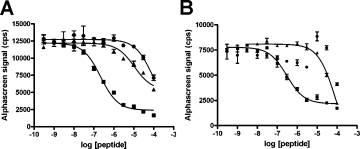Sequence requirement and subtype specificity in the high-affinity interaction between human frizzled and dishevelled proteins
- PMID: 19388021
- PMCID: PMC2771301
- DOI: 10.1002/pro.109
Sequence requirement and subtype specificity in the high-affinity interaction between human frizzled and dishevelled proteins
Erratum in
- Protein Sci. 2009 Jun;18(6):1333
Abstract
Members of the Wnt family of lipoglycoproteins initiate signaling by binding to Frizzled (Fz) receptors, and the signal is then relayed by Disheveled (Dvl). The Dvl PDZ domain is known to interact directly with a peptide derived from the KTXXXW motif of Fz7, which is conserved in all known Fz subtypes. We found that an extended region spanning the KTXXXW motif on both its N-terminal and C-terminal sides dramatically influences the affinity of peptides derived from Fz7 for Dvl PDZ. An alanine scanning study identified the specific residues external to the KTXXXW motif that are important for high-affinity binding. In a circular dichroism analysis, mutation of some of these critical residues resulted in peptide conformational changes, suggesting that the secondary structure of the peptides contributes to Fz-Dvl PDZ binding. Of the 10 known Fz subtypes, peptides derived from only Fz1, Fz2, Fz3, Fz4, and Fz7 directly bound to Dvl PDZ domain in our study. Other Fz subtypes, including some known to be involved in Wnt/beta-catenin signaling (Fz5, Fz9), did not bind to Dvl, suggesting that direct interaction with Dvl PDZ does not determine the subtype-specific functionality of Fz. Molecular modeling and circular dichroism studies indicated that the Fz peptides that bind to Dvl PDZ domain form specific conformations that are different from those of nonbinding peptides.
Figures





Similar articles
-
Wnt/β-catenin signaling requires interaction of the Dishevelled DEP domain and C terminus with a discontinuous motif in Frizzled.Proc Natl Acad Sci U S A. 2012 Apr 3;109(14):E812-20. doi: 10.1073/pnas.1114802109. Epub 2012 Mar 12. Proc Natl Acad Sci U S A. 2012. PMID: 22411803 Free PMC article.
-
Direct binding of the PDZ domain of Dishevelled to a conserved internal sequence in the C-terminal region of Frizzled.Mol Cell. 2003 Nov;12(5):1251-60. doi: 10.1016/s1097-2765(03)00427-1. Mol Cell. 2003. PMID: 14636582 Free PMC article.
-
Simulations of a specific inhibitor of the dishevelled PDZ domain.J Mol Model. 2009 Jan;15(1):91-6. doi: 10.1007/s00894-008-0377-x. Epub 2008 Oct 25. J Mol Model. 2009. PMID: 18953581
-
Dishevelled: The hub of Wnt signaling.Cell Signal. 2010 May;22(5):717-27. doi: 10.1016/j.cellsig.2009.11.021. Epub 2009 Dec 13. Cell Signal. 2010. PMID: 20006983 Review.
-
The cellular story of dishevelleds.Croat Med J. 2014 Oct;55(5):459-67. doi: 10.3325/cmj.2014.55.459. Croat Med J. 2014. PMID: 25358879 Free PMC article. Review.
Cited by
-
Identification of the first small-molecule inhibitor of the REV7 DNA repair protein interaction.Bioorg Med Chem. 2016 Sep 15;24(18):4339-4346. doi: 10.1016/j.bmc.2016.07.026. Epub 2016 Jul 16. Bioorg Med Chem. 2016. PMID: 27448776 Free PMC article.
-
The multifaceted role of CD146/MCAM in the promotion of melanoma progression.Cancer Cell Int. 2015 Feb 4;15(1):3. doi: 10.1186/s12935-014-0147-z. eCollection 2015. Cancer Cell Int. 2015. PMID: 25685061 Free PMC article.
-
Dishevelled-3 conformation dynamics analyzed by FRET-based biosensors reveals a key role of casein kinase 1.Nat Commun. 2019 Apr 18;10(1):1804. doi: 10.1038/s41467-019-09651-7. Nat Commun. 2019. PMID: 31000703 Free PMC article.
-
Wnt Signalosome Assembly by DEP Domain Swapping of Dishevelled.Mol Cell. 2016 Oct 6;64(1):92-104. doi: 10.1016/j.molcel.2016.08.026. Epub 2016 Sep 29. Mol Cell. 2016. PMID: 27692984 Free PMC article.
-
Molecular Role of RNF43 in Canonical and Noncanonical Wnt Signaling.Mol Cell Biol. 2015 Jun 1;35(11):2007-23. doi: 10.1128/MCB.00159-15. Epub 2015 Mar 30. Mol Cell Biol. 2015. PMID: 25825523 Free PMC article.
References
-
- Wodarz A, Nusse R. Mechanisms of Wnt signaling in development. Annu Rev Cell Dev Biol. 1998;14:59–88. - PubMed
-
- Luo J, Chen J, Deng ZL, Luo X, Song WX, Sharff KA, Tang N, Haydon RC, Luu HH, He TC. Wnt signaling and human diseases: what are the therapeutic implications? Lab Invest. 2007;87:97–103. - PubMed
-
- Gordon MD, Nusse R. Wnt signaling: multiple pathways, multiple receptors, and multiple transcription factors. J Biol Chem. 2006;281:22429–22433. - PubMed
-
- Veeman MT, Axelrod JD, Moon RT. A second canon. Functions and mechanisms of β-catenin-independent Wnt signaling. Dev Cell. 2003;5:367–377. - PubMed
-
- Yang-Snyder J, Miller JR, Brown JD, Lai CJ, Moon RT. A frizzled homolog functions in a vertebrate Wnt signaling pathway. Curr Biol. 1996;6:1302–1306. - PubMed
Publication types
MeSH terms
Substances
LinkOut - more resources
Full Text Sources
Molecular Biology Databases

